After a storm, start by evaluating safety hazards like downed power lines, broken glass, and unstable structures. Wear protective gear and prioritize clearing pathways before handling ash, silt, and organic debris. Use proper tools like shovels, HEPA vacuums, and power washers for effective removal. Dispose of waste responsibly, avoiding environmental contamination. To restore your land safely and efficiently, follow essential cleanup techniques—more tips await to guide your recovery process.
Key Takeaways
- Prioritize safety by inspecting for hazards, using PPE, and documenting damage before beginning cleanup.
- Develop a step-by-step plan focusing on debris removal, cleaning, and disinfection, starting with pathways.
- Use appropriate tools like shovels, power washers, and HEPA vacuums, and handle debris carefully to prevent contamination spread.
- Properly segregate and dispose of ash, silt, and organic waste following local regulations, ensuring environmental protection.
- Conduct regular site inspections and monitoring to assess damage, adapt cleanup strategies, and prevent future vulnerabilities.
Assessing the Post-Storm Environment and Safety Precautions
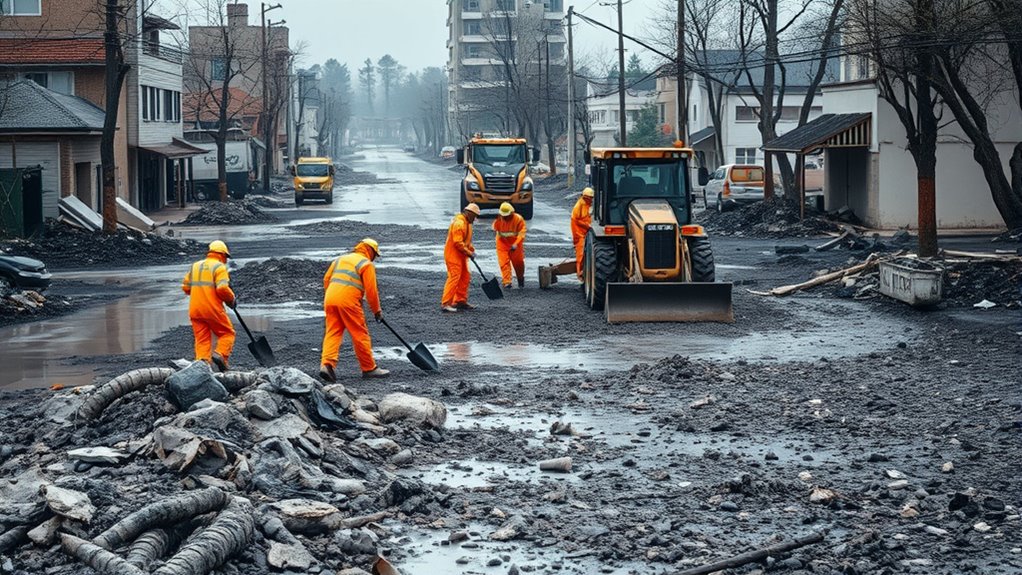
After a storm, it’s essential to carefully evaluate the environment before beginning recovery efforts. First, check for immediate hazards like downed power lines, broken glass, or unstable structures. Wear sturdy boots, gloves, and protective eyewear to guard against debris and contaminants. Avoid entering flooded areas until authorities confirm they’re safe, and be cautious of mold or sewage contamination. Inspect trees and utility poles for damage that could cause further hazards. Keep an eye out for gas leaks or exposed wiring, and turn off utilities if necessary. Document damage with photos for insurance claims. Stay informed through local updates, and don’t rush into cleanup. Prioritize your safety above all to prevent injuries or accidents during this critical stage. Vetted safety procedures are crucial for effective and secure recovery efforts.
Planning Your Cleanup Strategy and Prioritizing Tasks
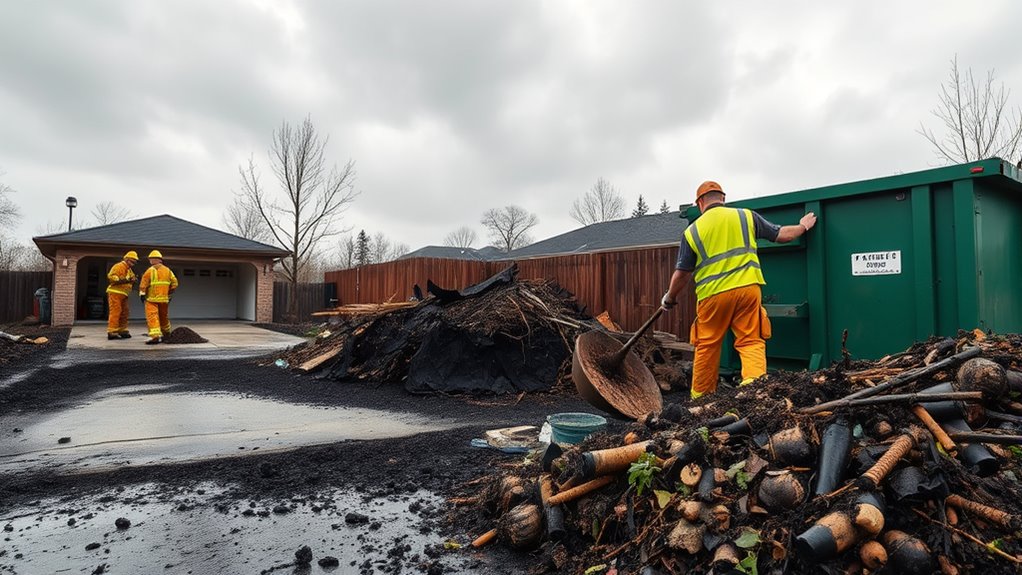
Once you’ve assessed the environment and addressed immediate hazards, you can begin developing a cleanup plan. Start by identifying the most affected areas that require urgent attention, such as those with standing water, fallen debris, or compromised structures. Prioritize tasks based on safety and importance—clear pathways first and then tackle heavily contaminated zones. Break down the cleanup into manageable steps, assigning specific tasks to each phase. Consider the sequence: remove debris, clean surfaces, and then disinfect. Keep in mind that some areas may need repeated cleaning, especially if ash, silt, or organic matter are deeply embedded. Developing a clear timeline and checklist helps keep the process organized and ensures you don’t overlook critical steps. Utilizing proper cleanup strategies can significantly improve the effectiveness and safety of your recovery efforts.
Essential Equipment and Tools for Ash and Silt Removal

Removing ash and silt effectively requires the right equipment and tools to guarantee safety and thorough cleaning. Start with high-quality respirators or masks to protect your lungs from fine particles. Use durable shovels and scoops to lift ash and silt without damaging surfaces. Heavy-duty wet/dry vacuums with HEPA filters are essential for containing airborne dust and preventing spread. Mop buckets, long-handled brushes, and scrubbers help clean surfaces thoroughly. Consider using power washers for exterior areas where silt has accumulated. Heavy gloves and protective clothing safeguard your skin from irritants. Make certain you have proper disposal containers to handle contaminated debris safely. Investing in these tools ensures a more efficient cleanup and reduces health risks during the recovery process. Proper protective equipment is crucial to prevent skin irritation and respiratory issues during cleanup.
Techniques for Safely Removing Organic Material and Debris

To eliminate organic material and debris safely, you need to wear proper personal protective equipment like gloves, masks, and eye protection. Use gentle disposal methods to avoid spreading contaminants and choose eco-friendly cleaners to safeguard your environment. Taking these precautions ensures both your safety and effective cleanup. Incorporating appropriate safety gear can further reduce the risk of exposure during cleanup efforts.
Proper Personal Protective Equipment
Are you aware of the essential personal protective equipment (PPE) needed to safely handle organic material and debris after a storm? Proper PPE shields you from contaminants, mold, and sharp objects. You should wear gloves, respirators, goggles, and long-sleeved clothing. Gloves protect your hands from cuts and bacteria, while respirators prevent inhaling harmful spores and dust. Goggles shield your eyes from splashes, and durable clothing minimizes skin exposure. Here’s a quick overview:
| PPE Item | Purpose |
|---|---|
| Gloves | Protect hands from cuts, bacteria |
| Respirator | Filter out mold, dust, spores |
| Goggles | Prevent debris from entering eyes |
| Long-sleeved clothing | Cover skin, avoid scratches |
| Boots | Protect feet from sharp objects |
Using the right equipment keeps you safe during cleanup. Being aware of the hazards involved helps ensure you take all necessary precautions.
Gentle Debris Disposal Methods
After a storm, handling debris carefully is essential to prevent further damage or injury. Use gentle techniques to remove organic material, such as raking or shoveling with care. Avoid aggressive scraping or heavy-duty equipment that could damage surfaces or disturb underlying layers. When lifting debris, bend your knees and lift with your legs to reduce strain. Place organic waste in separate, clearly labeled containers for easier disposal or composting. Take your time, especially with fragile materials like ash or wet silt, to avoid spreading particles into the air or water. If debris is too heavy or tangled, consider using hand tools like pruning shears or small scoops. Gentle handling minimizes the risk of injury and prevents causing additional damage to your property during cleanup. Additionally, understanding the importance of contrast ratio can help you assess the visual clarity and detail of your cleanup area, especially if you need to evaluate the extent of damage or residue left behind.
Use of Eco-Friendly Cleaners
Using eco-friendly cleaners is an effective way to safely remove organic material and debris after a storm while protecting the environment. These cleaners are non-toxic, biodegradable, and gentle on surfaces, making them ideal for storm cleanup. They help break down organic matter like mud, ash, and plant debris without releasing harmful chemicals into the air or water. Incorporating sustainable practices in cleanup efforts also supports the ongoing Climate change impacts faced by the tea industry, highlighting the importance of environmentally conscious methods.
Managing and Disposing of Ash, Silt, and Organic Waste Responsibly
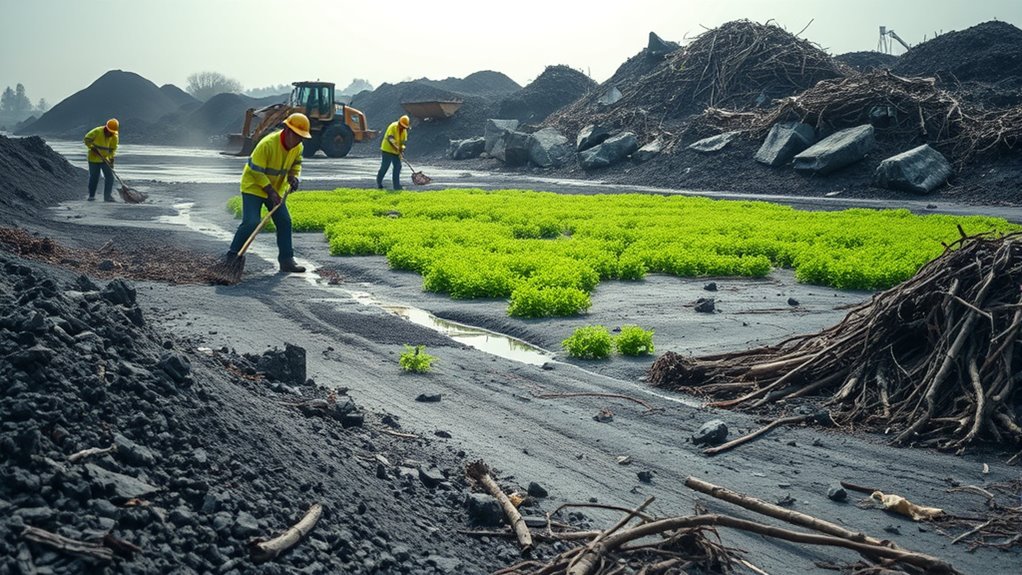
Managing and disposing of ash, silt, and organic waste responsibly is essential to minimize environmental impacts and protect public health. Always wear protective gear, such as gloves and masks, to prevent exposure to hazardous particles. Separate debris into appropriate containers to avoid cross-contamination. For ash and silt, check local regulations; many areas require disposal at approved facilities. Organic waste, like fallen branches and plant material, can often be composted or mulched, reducing landfill burden. Avoid burning debris or dumping waste in waterways, as this can cause pollution and blockages. Properly labeling and storing waste ensures safe handling and transportation. Exploring community forums and local tech communities can also provide valuable insights on proper disposal practices. By following these steps, you help prevent contamination, safeguard ecosystems, and contribute to a cleaner, healthier recovery process.
Preventing Environmental Contamination During Cleanup
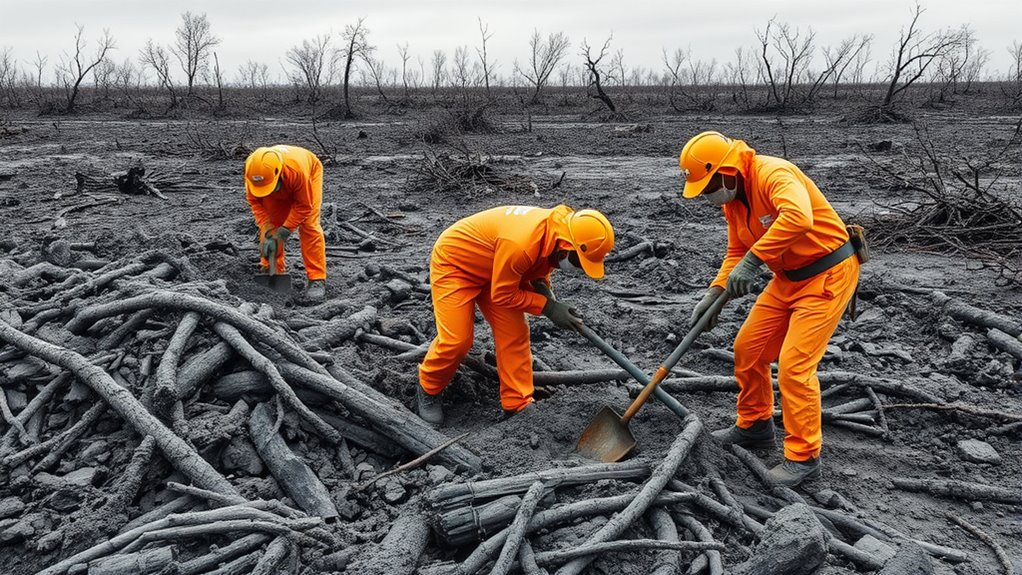
Proper disposal of ash, silt, and organic waste helps prevent environmental contamination during cleanup efforts. To do this effectively, focus on containment and proper handling. First, use heavy-duty plastic sheeting to create barriers around waste piles, preventing runoff into water sources. Second, set up designated containment areas with berms or dikes to keep debris from spreading. Third, always transport waste in sealed, labeled containers to avoid leaks and accidental spills. Additionally, avoid mixing waste types, as some materials may be hazardous when combined. Regularly monitor the site for leaks or runoff, especially during rain. Implementing necessary cookies can help track site conditions and ensure safety protocols are maintained. By following these steps, you minimize the risk of pollutants reaching soil, water, and wildlife, ensuring a safer, more responsible cleanup process.
Restoring Land and Property After Heavy Debris Accumulation
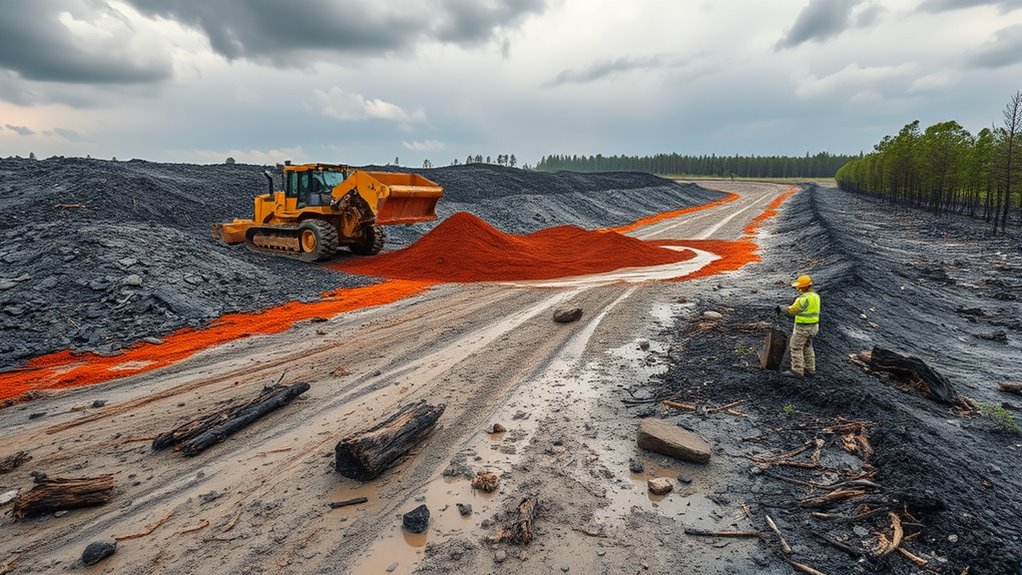
After a storm deposits heavy debris across your land and property, restoring the area requires prompt and strategic action. Start by removing large debris like fallen branches, trees, and broken structures carefully to prevent further damage. Use appropriate tools and protective gear to guarantee safety. Clear pathways and open access points to facilitate cleanup and future repairs. Once the larger debris is cleared, evaluate the soil and landscape for erosion or compaction. Consider grading uneven areas to promote proper drainage and prevent water pooling. If necessary, add topsoil or fill to restore the land’s natural contour. Address any structural damage to fences, outbuildings, or paved surfaces promptly to secure your property. Incorporating landscape assessment can help identify other potential issues before they worsen. Proper, swift intervention helps prevent further deterioration and prepares the land for ongoing recovery efforts.
Long-Term Monitoring and Maintenance for Post-Storm Recovery
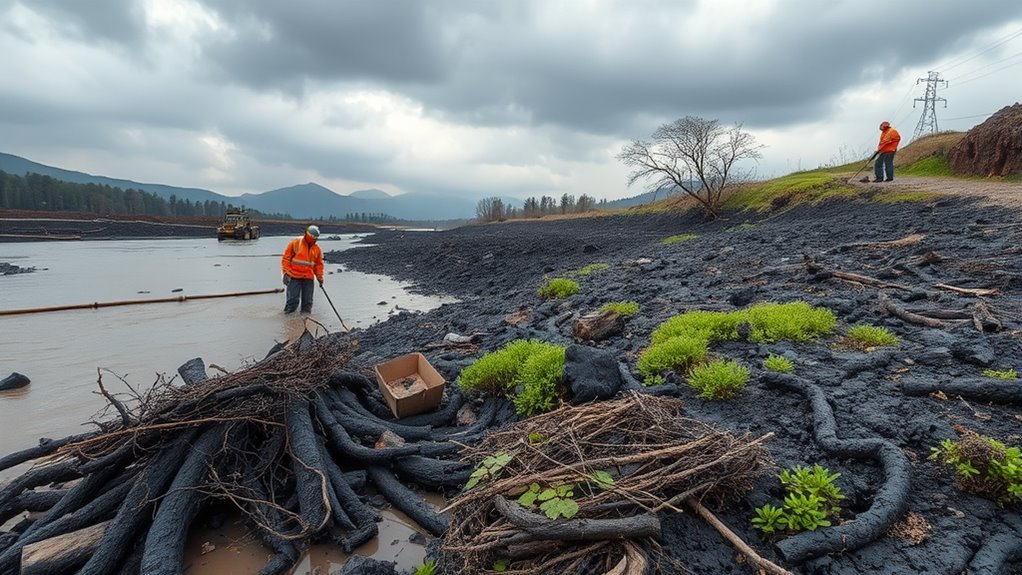
Implementing a regular inspection schedule helps you catch issues early and prevent further damage. Adaptive maintenance strategies allow you to modify your approach as conditions change over time. Staying proactive ensures your recovery efforts remain effective long after the storm has passed.
Regular Inspection Schedule
How often should you inspect your property after a storm to guarantee ongoing safety and stability? Initially, check it immediately after the storm, then schedule regular inspections to catch issues early. A good routine includes:
- Weekly inspections during the first month, looking for new cracks, erosion, or debris buildup.
- Bi-weekly checks over the next two months to monitor ongoing changes.
- Monthly assessments for the following six months as conditions stabilize.
During each inspection, focus on vulnerable areas like slopes, drainage systems, and tree health. Keep an eye out for signs of shifting soil, damaged structures, or blocked waterways. Consistent monitoring helps you address issues before they escalate, ensuring your property remains safe and resilient.
Adaptive Maintenance Strategies
Building on your regular inspection routine, adopting adaptive maintenance strategies guarantees your property stays resilient over the long term. These strategies involve adjusting your maintenance plans based on changing conditions and new insights from ongoing monitoring. After a storm, you should regularly assess the effectiveness of your cleanup efforts and identify emerging issues like foundation shifts or erosion. Use data from inspections and weather forecasts to prioritize repairs and schedule proactive interventions. Flexibility is key; don’t stick rigidly to a set plan if new risks or damage appear. Implementing adaptive tactics helps you address vulnerabilities early, preventing costly damage down the line. This approach ensures your property remains stable, safe, and prepared for future storms.
Frequently Asked Questions
How Do I Identify Hidden Hazards Beneath Debris During Cleanup?
You should carefully inspect the debris for signs of hidden hazards like sharp objects, unstable materials, or exposed electrical wires. Use a sturdy stick or tool to gently probe beneath the surface before handling. Wear protective gear, including gloves and boots, and proceed slowly to avoid disturbing potential dangers. Always assume there could be unseen hazards, and if in doubt, consult professionals for safe removal and assessment.
What Are Eco-Friendly Options for Disposing of Organic Waste?
You can opt for composting organic waste, which transforms it into nutrient-rich soil naturally. Use compost bins or piles, ensuring proper balance of greens and browns to speed up decomposition. Consider community composting programs or local organic waste collection services if available. Mulching organic matter like leaves and grass clippings also recycles nutrients back into your garden without harming the environment. These eco-friendly options help reduce landfill waste and promote sustainable practices.
How Can I Prevent Future Storm Damage in Vulnerable Areas?
You can prevent future storm damage by reinforcing vulnerable areas with natural barriers like planting deep-rooted native vegetation to stabilize soil. Install rain gardens and permeable pavements to improve water absorption, reducing runoff. Regularly maintain drainage systems and remove debris to prevent blockages. Consider elevating structures in flood-prone zones and creating buffer zones with trees to absorb excess water. These steps help protect your property and mitigate storm impact effectively.
Are There Specific Safety Protocols for Working With Contaminated Ash?
You should wear full protective gear, including N95 masks, goggles, and gloves, to shield yourself from contaminated ash. Always work in well-ventilated areas and avoid inhaling dust clouds that swirl like smoky fog. Follow strict safety protocols, such as proper disposal of contaminated materials and thorough handwashing afterward. These precautions keep you safe as you navigate the gritty, hazardous landscape left behind by the storm.
What Community Resources Are Available for Post-Storm Recovery Assistance?
You can access community resources like local emergency management offices, relief organizations, and neighborhood support groups for post-storm recovery help. These organizations often offer assistance with debris removal, financial aid, mental health support, and cleanup supplies. Reach out to your city or county’s official website for contacts and programs. Additionally, many communities have volunteer groups ready to assist with recovery efforts, so don’t hesitate to ask for help.
Conclusion
As you clear the ash, silt, and organic overload, remember that your efforts are the first brushstroke on the canvas of recovery. Staying vigilant and responsible guarantees the land heals beneath your hands, like a phoenix rising from the ashes. By respecting safety guidelines and environmental considerations, you help transform chaos into renewal. Your perseverance turns the storm’s aftermath into a foundation for resilience, proving that even in destruction, new life can bloom.









